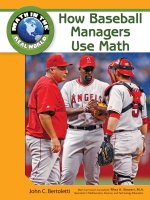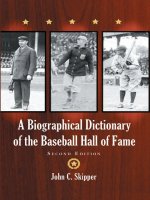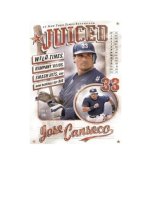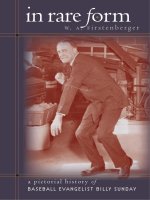BaseBall superstars Mike Piazza potx
Bạn đang xem bản rút gọn của tài liệu. Xem và tải ngay bản đầy đủ của tài liệu tại đây (1.46 MB, 137 trang )
Mike Piazza
BaseBall
superstars
Hank Aaron
Ty Cobb
Lou Gehrig
Derek Jeter
Randy Johnson
Mike Piazza
Kirby Puckett
Jackie Robinson
Ichiro Suzuki
Bernie Williams
Mike
Piazza
Mike
Piazza
Nick Friedman
BaseBall
superstars
For Caroline. What a year.
MIKE PIAZZA
Copyright © 2007 by Infobase Publishing
All rights reserved. No part of this book may be reproduced or utilized in any form or
by any means, electronic or mechanical, including photocopying, recording, or by any
information storage or retrieval systems, without permission in writing from the publisher.
For information, contact:
Chelsea House
An imprint of Infobase Publishing
132 West 31st Street
New York NY 10001
Library of Congress Cataloging-in-Publication Data
Friedman, Nick.
Mike Piazza / Nick Friedman.
p. cm. — (Baseball superstars)
Includes bibliographical references and index.
ISBN-13: 978-0-7910-9493-8 (hardcover)
ISBN-10: 0-7910-9493-6 (hardcover)
1. Piazza, Mike, 1968– 2. Baseball players—United States—Biography. 3. Los Angeles
Dodgers (Baseball team). I. Title. II. Series.
GV865.P52F75 2007
796.357092—dc22 2007006212
Chelsea House books are available at special discounts when purchased in bulk quantities
for businesses, associations, institutions, or sales promotions. Please call our Special Sales
Department in New York at (212) 967-8800 or (800) 322-8755.
You can find Chelsea House on the World Wide Web at
Series design by Erik Lindstrom
Cover design by Ben Peterson
Printed in the United States of America
Bang FOF 10 9 8 7 6 5 4 3 2 1
This book is printed on acid-free paper.
All links and Web addresses were checked and verified to be correct at the time
of publication. Because of the dynamic nature of the Web, some addresses and links
may have changed since publication and may no longer be valid.
Greatest Hitting Catcher of All Time
1
Growing Up in Pennsylvania
9
High School and Beyond
19
Looking to Prove Himself
29
The Rookie Arrives
40
True Stardom
53
Top Dodger
63
Starting Over
74
The New York Years
86
Piling Up the Numbers
100
Statistics 113
C
hronology and Timeline 114
Glossary 1
17
Bibliography 120
F
urther Reading 124
Index 1
26
1
2
3
4
5
6
7
8
9
10
CONTENTS
Hitting Catcher
of All Time
1
1
M
ike Piazza had one thing on his mind when he stepped up
to the plate for the first time in the New York Mets’ game
against the San Francisco Giants. It was May 5, 2004, and the
Mets’ slugger desperately wanted to hit a home run.
Hitting homers was as natural as breathing air to Piazza.
In 11 years in the big leagues as a catcher, he had smashed 351
round-trippers of every kind: line-drive rockets, towering moon
shots, bottom-of-the-ninth blasts, crushing grand slams. Piazza
knew, however, that the next ball he sent screaming over the
fence would be something special, something for the ages. The
next home run would guarantee him a place in baseball history.
Trouble was, Piazza had been trying too hard to hit hom-
ers lately. A good hitter needs to be relaxed in the batter’s box
and focus on making solid contact with the ball. If a home run
2
MIKE PIAZZA
comes, it is a bonus. Piazza had been “pressing at the plate” as
major leaguers say, and it showed. After belting three home
runs in his first two games of the season, he had gone 16 games
before clearing the fence again. Then came another dry spell of
six games.
Would tonight’s game against the Giants at Shea Stadium
in New York be number seven?
It would not take long to find out. Mets manager Art Howe
had written Piazza’s name into the third spot of the batting
order, the place typically reserved for a team’s best all-around
hitter. The “three-hole” hitter swings a bat as skillfully as an
artist wields a paintbrush. He usually collects plenty of hits for
a high batting average. Yet he also has the power to launch the
ball deep into the outfield and even into the seats for a homer.
His main job is to drive in the first two batters in the lineup
should they get on base. Because he was batting third, Piazza
was getting his first crack at making baseball history in the bot-
tom of the first inning.
Tonight, however, the first two Mets batters made outs,
leaving the bases empty when No. 31 stepped into the batter’s
box. Piazza, a right-handed batter, dug his feet into the dirt
and took some practice swings with his 32-ounce bat, the same
model he had used since his days in the minor leagues. Out
on the mound, San Francisco pitcher Jerome Williams, just
22 years old and in his second big-league season, took a deep
breath and got ready to go head to head with one of baseball’s
most feared power hitters.
Williams wound up and threw his first pitch. It sailed
outside the strike zone, and Piazza wisely let it go by for ball
one. The umpire signaled ball two when the right-hander’s
next pitch missed the plate again. Was the showdown making
Williams nervous?
Two pitches later, the count was three balls and one strike,
giving Piazza an advantage. Like a hungry wolf about to devour
a big, fat lamb chop, Piazza knew that Williams would have
3
A baseball manager is free to arrange his team’s batting order
any way he likes. Through the years, though, a common wisdom
has developed about where to place certain types of hitters in the
order to produce the most runs. Here is the thinking: The job of
the leadoff hitter is to get to first base any way he can—through
a walk, a single, a bunt, even getting hit by a pitch—and then
move into scoring position. For that reason, he is usually one of
the fastest runners on the team. The number-two batter is also
fast and should be able to make good contact with the ball to
help advance the leadoff batter. The third batter may be the best
all-around hitter on the team and will drive in a run or get on
base himself. That brings up the cleanup hitter. Usually the most
powerful batter, he is there to clean the bases of runners—think
of what happens when a batter smashes a grand slam.
The fifth hitter also packs power, can drive in runs, and may
have another job: to “protect” the cleanup hitter through his
presence as a strong hitter. An opposing pitcher who fears the
cleanup hitter and wants to walk him on purpose will think twice
about that strategy if he knows the fifth hitter can drive him in.
The sixth batter is a power hitter as well and collects RBIs, and
the seventh and eighth batters are generally not good hitters.
They still need to be able to reach base, however.
Finally, the ninth place in the order is typically reserved for
the pitcher in the National League and, therefore, is the weakest
of all at the plate. In the American League, however, a desig-
nated hitter bats in place of the pitcher (in another part of the
order). That opens the ninth spot to a more skilled hitter. Some
managers like this player to have skills like the leadoff hitter to
ignite the team if he happens to come up as the first batter in
later innings.
how does a batting order work?
Greatest Hitting Catcher of All Time
4
MIKE PIAZZA
to throw his next pitch for a strike or risk walking him with
ball four.
Williams gripped the ball inside his glove and then reared
back and delivered a fastball toward the plate. Piazza feasted
on fastballs. This one came in low, but Piazza reached down
and swatted it, putting all 215 pounds (97.5 kilograms) of his
muscled body into the swing. Whack! The crack of the bat
sent the ball arcing high into the nighttime air. No one was
going to catch this baby. It flew way over the fence in right-
center field and bounced off the lower part of the scoreboard,
405 feet (123 meters) away from home plate. That ball was
out of here!
Piazza had done it. He had blasted his 352nd career homer,
breaking the all-time record for home runs by a major-league
catcher. His name would be written alongside the immortals
of the game forever. With a happy smile on his face, Piazza
trotted around the bases as the dramatic theme music from
the movie Chariots of Fire echoed over the stadium’s speakers.
When he reached home plate, Piazza’s teammates swallowed
him up in a sea of high fives, chest bumps, and helmet taps.
Meanwhile, Shea Stadium’s 19,974 fans stood up and roared
their approval. Piazza ducked into the Mets dugout, but a few
moments later, the crowd was still going wild. Piazza bounced
back up and tipped his cap in thanks. The fans could not get
enough of him. It was like a curtain call on the Broadway
stage after an amazing performance by an actor.
After the game (which the Mets won, 8-2), Piazza felt
relieved. With the pressure to hit his landmark homer finally
off his back, the newly crowned King of Catchers told a
reporter for the New York Times, “I’m really excited and really
proud. I’m blessed. I’ve lived a dream.”
Piazza’s words were right on target. For those who
knew his story and how he beat the odds to reach the
majors, his accomplishment was indeed a dream—an almost
impossible dream.
5
At Shea Stadium, Mike Piazza hit his 352nd career home run as a
catcher in the first inning of a game between the New York Mets and
the San Francisco Giants on May 5, 2004. With the round-tripper,
Piazza passed Carlton Fisk as the all-time career home-run leader
among catchers.
Greatest Hitting Catcher of All Time
6
MIKE PIAZZA
LONG ROAD TO THE TOP
Major League Baseball is filled with legendary home-run hit-
ters. Babe Ruth, Hank Aaron, and Willie Mays are three of the
greatest of all time. Each is enshrined in the National Baseball
Hall of Fame in Cooperstown, New York. In today’s game,
superstars Manny Ramírez, Ken Griffey, Jr., and Alex Rodri-
guez are making their marks with awesome displays of power
that will surely land them in the Hall of Fame one day, too. All
six of those players have hit more career home runs than Mike
Piazza. But none of them succeeded in the way Piazza did.
Few people thought Piazza had the all-around ability
to make it to the big leagues. Growing up in Phoenixville,
Pennsylvania, Piazza was an excellent hitter. When he was a
senior at Phoenixville Area High School, his batting average
was an astounding .442. He also belted 11 home runs. But
Piazza had two glaring weaknesses on the diamond: He was a
slow runner, and his fielding was poor (Piazza played first base
at the time). As a result, no major-league teams were interested
in the star from Phoenixville High.
Piazza went on to play college baseball. After hitting .364 in
his sophomore season, the Los Angeles Dodgers chose Piazza in
the 1988 draft of amateur ballplayers. Usually, players with the
most major-league potential are chosen in the first two rounds
of the draft. Other solid players may be taken in the third or
fourth round. Los Angeles selected Piazza in the sixty-second
round—after 1,389 players had already been taken. That is like
turning a bag of potato chips upside down and dumping out
the last salty crumbs.
Los Angeles sent Piazza to its lowest minor-league team for
rookies, in 1989. The Dodgers had asked Piazza to switch posi-
tions from first base to catcher. Though catcher is one of the
most demanding jobs in baseball, Piazza agreed. He figured
the move would give him a better chance of making it to the
majors, where hard-hitting “backstops” are a rare breed. Over
the next four years in the minors, Piazza dedicated himself
7
to mastering the skills behind the plate: giving signals to the
pitcher, blocking bad pitches in the dirt, snapping off quick
throws to second base to nail runners trying to steal.
Mike Piazza, playing for the Mets, tagged out Houston’s Moisés Alou at
home plate to end the ninth inning of a 2001 game in Houston. The Los
Angeles Dodgers drafted Piazza way down in the sixty-second round of
the 1988 amateur draft. Piazza switched from first base to catcher, one
of the most demanding positions in baseball, in the hope of improving
his chances to make it to the major leagues.
Greatest Hitting Catcher of All Time
8
MIKE PIAZZA
Late in the 1992 season, the Dodgers brought Piazza up
from the minors to give him a taste of the big-league game. The
following year, Piazza’s first full season in the majors, he gave
the Dodgers a taste of his game—and the greatness to come.
He hit 35 home runs, setting a big-league record for a rookie
catcher. He also threw out 58 runners trying to steal, the most
of any catcher that season. At season’s end, Piazza was rewarded
with the National League’s Rookie of the Year trophy.
Now playing for his fifth team, the Oakland A’s, the 12-time
All-Star still thrills fans with his long-ball show while he adds
polish to his Hall of Fame credentials. Piazza has won a record
10 Silver Slugger awards, an honor given to the best hitter at
each position. His .362 batting average in 1997 was the highest
by a catcher going all the way back to 1936, and it remains so
to this day. In 2000, he drove in at least one run in 15 straight
games, tying the longest RBI streak in major-league history. He
swatted his 400th career homer in early 2006.
As a kid, Piazza adored everything about baseball and
dreamed of playing in the pros. He practiced his batting stroke
over and over, first in his family’s basement and later in a back-
yard batting cage built by his dad. Given a rare opportunity to
prove his worth in the minors, Piazza drove himself tirelessly to
learn the position that would give him his best shot of making
it to “The Show,” as the big leagues are often called. When he
arrived, Piazza set a new standard of hitting excellence for all
major-league catchers to come.
Growing Up in
Pennsylvania
9
2
A
sk any boy what he wants to be when he grows up, and
chances are, he will give you two or three answers: “I want
to be a bus driver, like my dad,” he might say. Or, “I want to test
new video games.” But you can bet two weeks’ allowance that
one of the answers will include a job in pro sports. “I want to
play in the NBA.” “I’d like to be the quarterback for the Pitts-
burgh Steelers.” “I’m going to pitch for the New York Yankees
and hit in the three hole after Derek Jeter and win Game 7 of
the World Series at Yankee Stadium.”
Who can blame a kid for wanting to play in the pros one
day? Let’s face it, sports stars rule. They are millionaires who
drive fancy cars and have the coolest toys. They appear on
television and sign autographs. Perhaps best of all, they play a
game and get paid for it. That’s not a job—that’s pure fun.
10
MIKE PIAZZA
The average salary of a big-league baseball player in 1974 was
about $41,000 a year. In 2006, Alex Rodriguez of the New York
Yankees earned nearly that much each time he stepped up to the
plate. A-Rod’s 2006 salary was $21.6 million, the highest in the big
leagues. Although his income is an extreme example of the huge
sums that major leaguers are paid, it helps illustrate the vast wealth
available to the modern player. The average salary in 2006 was
$2.7 million.
How did baseball players become so rich? Why are they paid
so much? Those two questions can be answered with a two-word
phrase: free agency. Until the early 1970s, a player was the prop-
erty of the team that signed him first. He had little say about his
salary because the team owned his rights even after his contract
expired. The only way he could go to another team was by being
traded. Outfielder Curt Flood of the St. Louis Cardinals challenged
this century-old rule (called the “reserve clause”) in 1970 and took
his case all the way to the Supreme Court in 1972. He lost, but by
1975, the rule had been abolished, and players became free agents
who could negotiate with any team once their contracts expired.
Team owners today make plenty of money from ticket sales,
souvenir sales (such as T-shirts and caps), television- and radio-
broadcasting rights, and stadium parking fees. Over the years, the
players have tapped into this fountain of wealth—as they should,
since they are the ones fans pay to see. In 1983, the average
major-league salary was $289,000 per year. The figure climbed
to $597,000 in 1990 and reached $2 million in 2000. From time
to time, the team owners have tried to limit the salaries, but the
players have resisted, sometimes by going on strike. As long as the
money keeps flowing into the owners’ pockets, players will con-
tinue to fight to get their share.
big stars, big salaries
11
Growing Up in Pennsylvania
Mike Piazza was no different from any other kid growing
up. By the time he was eight years old, he knew what he wanted
to be. “My second-grade teacher wrote me a letter [after I made
it to the big leagues] to tell me she still has a paper I wrote
about how I wanted to play Major League Baseball,” Piazza told
Stack magazine in a 2006 interview. “[The dream] definitely
starts at a young age.”
LITTLE MIKE
Michael Joseph Piazza was born in Norristown, Pennsylvania,
on September 4, 1968, to Veronica and Vincent Piazza. The tiny
(future) slugger in diapers was the second of Mr. and Mrs. Piaz-
za’s five children. Vince, Jr., born two years before Mike, was top
dog. After Mike came Danny, followed by Tony and Tommy.
The Piazzas lived in a modest house in Phoenixville,
Pennsylvania, a small suburban town 28 miles (45 kilome-
ters) northwest of Philadelphia. Vincent, Sr., earned a living
as the owner of a used-car dealership. Veronica was a stay-at-
home mother.
With five boys, Mrs. Piazza’s work was cut out for her. The
Piazzas were close, and the household was never lacking for
action, fun, games—and the horseplay that goes on among
brothers. The boys tossed baseballs and footballs in the back-
yard, wrestled, busted the occasional lamp, argued over who
controlled the television, and no doubt battled for the last slice
of pizza. In short, it was a typical childhood for the brothers.
But Mike’s early years were really all about his fascina-
tion with baseball. It occupied his thoughts and dreams. He
was obsessed. In an interview with Sports Illustrated for Kids
magazine in September 2000, Piazza was asked which book was
his favorite when he was a kid. He answered Baseball Players
Do Amazing Things, a collection of stories about some of the
immortals of the game that he received as a gift one Christmas.
Asked by the same magazine in April 1998 to name the person
from history he would most like to meet, he replied Babe Ruth,
12
MIKE PIAZZA
the New York Yankees’ home-run king and arguably the great-
est baseball player of all time.
Mike’s fascination with the sport was bred into him by
his father. Mr. Piazza was a baseball nut raised in Norristown,
across the street from a homegrown star named Tommy
Lasorda. Although Lasorda was six years older, the two boys
were friends. Blessed with serious talent as a left-handed
pitcher, Lasorda played in the minor leagues in the late 1940s
and early 1950s. He was called up to the big leagues by the
Brooklyn Dodgers in 1954, but he just did not have the stuff
to get major-league hitters out. He pitched only 26 games from
1954 to 1956 with the Dodgers and later the Kansas City A’s,
and he finished his career with a record of no wins and four
losses. Lasorda, though, went on to greatness years later as the
manager of the Los Angeles Dodgers. In 21 seasons in charge of
the Dodger dugout, Lasorda led Los Angeles to eight division
titles and two World Series championships (1981, 1988).
The year Mike turned eight, 1976, also happened to be when
Lasorda became manager of the Dodgers. You have to know
that Mr. Piazza was bursting every time his old Norristown
buddy and the Dodgers appeared on television. Imagine the
excitement, not to mention the mixed feelings that were stirred
up inside Mike’s dad, whenever the hometown Phillies played
the Dodgers. Which team should he root for?
If you could take a trip back in time to the Piazza home on
a Saturday morning in 1976, you would find Mike camped in
front of the TV watching his favorite cartoons. Sticking around
into the afternoon, you might catch a Phillies game with him on
the radio. The Phils were Mike’s favorite team. And what a team
they were. In the 1976 season, Philadelphia won 101 games, its
best regular-season record ever. They were led by left-handed
strikeout ace Steve Carlton, who won 20 games that season, the
mark of excellence for a major-league pitcher.
You would have to cheer for the Phils with Mike in the
room, of course, but you had better go quiet whenever third
13
Growing Up in Pennsylvania
Tommy Lasorda was a pitcher in the 1950s with the Brooklyn Dodgers.
He had much more success decades later as the manager of the Los
Angeles Dodgers. Mike Piazza’s father, Vincent, Sr., grew up across the
street from Lasorda in Norristown, Pennsylvania. Their friendship would
have a major influence on Mike Piazza’s career.
14
MIKE PIAZZA
baseman Mike Schmidt stepped up to the plate. Schmidt
was young Mike Piazza’s idol. It’s no wonder. With a unique
combination of power and fielding excellence, Schmidt was
one of the best third basemen of all time. In 1976, No. 20 won
the National League home-run title with 38 blasts, including
four in one game against the Chicago Cubs. Schmidt played
18 seasons in the majors, slugging 548 home runs and win-
ning three National League Most Valuable Player awards
(1980, 1981, 1986). He retired after the 1989 season and was
elected into the Baseball Hall of Fame five years later.
After the Phils game was over, you would grab a bat
and head down to the Piazzas’ basement, where it was time
for some serious baseball work. Baseball? In the basement?
That’s right. Taking his son’s passion for the game to heart,
Mr. Piazza had propped an old mattress up against the wall
so that Mike could practice hitting baseballs into it without
the risk of breaking anything. Sometimes Mike hit the ball
off a batting tee, and sometimes his dad would pitch to him.
Crack-Thump! Crack-Thump! Crack-Thump! The rhythm
of Mike’s bat driving the ball into the frumpy mattress
became a familiar sound throughout the Piazza house.
On Sundays, you would find the Piazzas at church.
Growing up Catholic, Mike and his family attended services
every week. “Religion, our faith, has always been a big part
of our family,” Veronica Piazza told the Pottstown Mercury
newspaper in July 2004.
At age nine, Mike joined his first youth-league baseball
team, the A’s. His coach was a man named Abdul Ford-Bey, a
legend in Phoenixville for his volunteer work with boys and
girls in baseball, softball, and basketball. Ford-Bey taught
Mike and his teammates the fundamentals of the game. The
next year, Mike moved on to a team called the Cardinals. His
new coach put him on the field as a catcher. Mike did not
like the position. Like many kids first learning the game, he
15
One of Mike Piazza’s childhood idols was Mike Schmidt, the third base-
man for the Philadelphia Phillies. Schmidt hit 548 home runs during his
18-year baseball career in the 1970s and 1980s.
Growing Up in Pennsylvania
16
MIKE PIAZZA
wanted to be a pitcher, the one player on the field in control
of the game.
When Mike was 11, Mr. Piazza had a wild idea one day.
One way that major leaguers improve their hitting skills is by
practicing their strokes inside a batting cage with a pitching
machine tossing ball after ball toward the plate. Mr. Piazza
thought: Why not give Mike the same opportunity to improve
his hitting skills—at home? So at a point when most fathers
and sons were building go-carts together, Mike’s dad got some
lumber, and some netting, and made Mike his own batting
cage in the family’s backyard. Then Mr. Piazza took his plan
one giant step further: He bought a real pitching machine and
installed it inside the batting cage.
Mike was in heaven. The cage became his hangout for the
next nine years. “I was out there every day,” Piazza told Sports
Illustrated magazine in 1993. “I would come home from school,
get a snack, watch cartoons, and then hit.” Mike smacked about
300 balls a day, no matter the weather—rain or shine, sleet
or snow. In the winter, he would shovel snowdrifts out of the
cage, heat the baseballs on the stove, and wrap pipe insulation
around the bat handle so his hands would not sting when he
made contact with the ball in the freezing cold.
Did all that practice pay off? You better believe it. “The
more I hit, the better I did in Little League,” Piazza told an
interviewer in 2003. “By the time I was 13, I’d made the all-
star team.”
Eventually, Mr. Piazza made the cage more comfortable
for Mike by adding a roof on top and enclosing the sides
with wood paneling. He also put in a heater. The batting cage,
though, was no thing of beauty by any stretch of the imagina-
tion. In fact, one day, some Phoenixville government officials
visited the Piazza home to investigate the curious structure.
As stated in the Sports Illustrated interview, when the officials
asked Mr. Piazza what it was, he told them, “It’s my son’s ticket
to the major leagues.”
17
ONE TOUGH SPORTS PARENT
If it seems weird for a father to build his son a professional
batting cage in the backyard and spend money on a real
pitching machine, you are right. Most fathers do not do those
things. But almost from the start of Mike’s interest in baseball,
Mr. Piazza was as obsessed with Mike’s love of the game as
Mike. Maybe even more so.
Vince Piazza was a man who drove himself hard in all that
he did. Born poor, he dropped out of high school at age 16 to
get a job and help support his parents. Mr. Piazza, though, was
smart and aggressive. He was not going to let his lack of formal
education get in his way of achieving the American Dream.
He saved money as if it were going out of style. After buying a
used-car dealership, he began to invest money in real estate and
other interests. Around the time Mike was 13, his investments
began to pay off and he starting earning big bucks. He bought
more car dealerships. He also opened a computer services com-
pany. In time, he became a multimillionaire.
As the cash rolled in, Mr. Piazza invested more money—
and time—into Mike’s baseball talent. According to a 1994
interview in the Los Angeles Times Magazine, Mr. Piazza
“
decided that his son, like it or not, was ‘gonna play baseball’ ”
as a professional.
Why did Mr. Piazza focus on Mike and not his other sons?
Here’s how he answered in the same interview: “When Vince,
Jr., and Mike were kids, I looked at them both and asked myself,
‘Which one has the best chance of playing pro baseball?’ Mike
was younger, 11, but bigger. I chose Mike. I pushed and pushed
that kid.”
Today, this kind of sports parent is all too familiar. He’s
the father who likes to tell a coach how to run the team. The
dad who buys his son all the top-of-the-line equipment before
the old gear even gets dirty, demands special treatment from
coaches for his son, enrolls his boy in training clinics year-
round, and yells at the umpire if he disagrees with his calls.
Growing Up in Pennsylvania
18
MIKE PIAZZA
Worst of all, he drives his own kid to succeed and criticizes him
if he does not perform up to his expectations.
Mike loved his dad, and he appreciated his support.
After all, Mike sought the same goal as his dad—to become
a major leaguer. Years later, Mike realized that his father had
at times pushed him too hard, too often. He would be labeled
“spoiled” by others who doubted his talent, which hurt Piazza
deeply. But when he was 11, 12, 13 years old, Mike followed
his dad’s wishes.
In the years to come, Mr. Piazza would use his influence
and money to give Mike a series of golden opportunities to
sharpen his game that would make any young baseball player
green with envy. Mike, to his credit, would seize each one of
those opportunities and use it to the best of his ability. One
such opportunity included receiving batting tips at age 16 from
one of the finest pure hitters the sport has ever known. It would
be a moment Mike would never forget.









